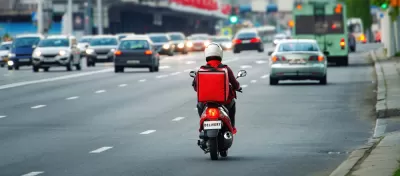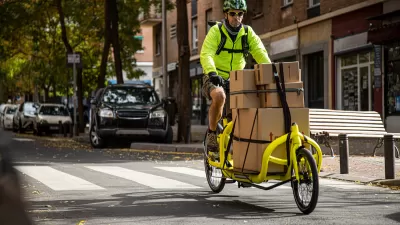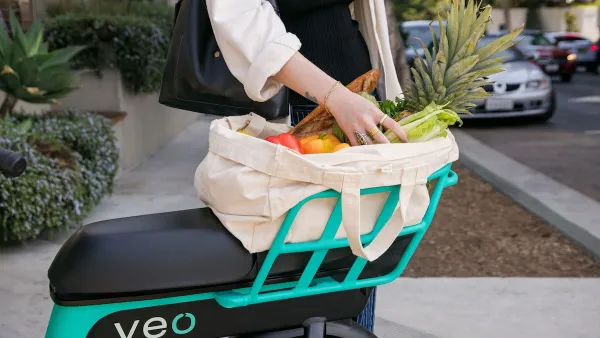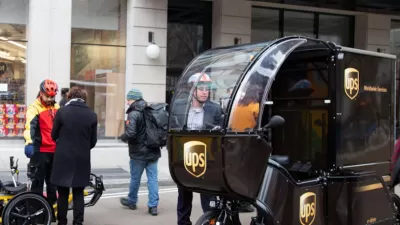Facilitating the use of micromobility devices for the last mile of urban deliveries can reduce congestion, lower emissions, and take bigger vehicles off small neighborhood roads.

A whitepaper commissioned by Uber describes the potential for micromobility to improve last-mile delivery of goods, which, for the most part, are currently delivered by cars and trucks. As reported by Charles Pekow in Smart Cities Dive, “Use of micromobility vehicles for those last-mile deliveries can bring a variety of benefits in urban areas — benefits some cities are already realizing, the whitepaper states.”
While these devices aren’t practical everywhere, the paper notes five strategies cities can implement to improve infrastructure for micromobility deliveries:
- Make micromobility users feel safe by taking Vision Zero and Safe Systems approaches to road infrastructure, regulations and communications.
- Facilitate safe and easy pick-up and drop-off of deliveries such as through curbside management strategies and building codes.
- Provide policy leadership in support of micromobility such as net zero emissions goals and innovation incubators.
- Support remoding of last-mile deliveries through micro-logistics hubs and other efforts.
- Test and scale ideas that work.
The article notes that bike delivery is nothing new, dating back more than a hundred years. “The whitepaper documents how other cities have successfully implemented bike delivery services. For example, after Toronto improved its cycling network, Uber Eats saw its bike deliveries in that city increase 40% from 2019 and 2020, Uber said. A 2019 project in New York City more than doubled cargo bike deliveries in the covered area, with each cargo bike that replaced a van or box truck resulting in about 7 tons fewer of annual CO2 emissions.”
FULL STORY: 5 strategies to advance micromobility for urban last-mile delivery: report

Planetizen Federal Action Tracker
A weekly monitor of how Trump’s orders and actions are impacting planners and planning in America.

The Simple Legislative Tool Transforming Vacant Downtowns
In California, Michigan and Georgia, an easy win is bringing dollars — and delight — back to city centers.

San Francisco's School District Spent $105M To Build Affordable Housing for Teachers — And That's Just the Beginning
SFUSD joins a growing list of school districts using their land holdings to address housing affordability challenges faced by their own employees.

In More Metros Than You’d Think, Suburbs are Now More Expensive Than the City
If you're moving to the burbs to save on square footage, data shows you should think again.

The States Losing Rural Delivery Rooms at an Alarming Pace
In some states, as few as 9% of rural hospitals still deliver babies. As a result, rising pre-term births, no adequate pre-term care and "harrowing" close calls are a growing reality.

The Small South Asian Republic Going all in on EVs
Thanks to one simple policy change less than five years ago, 65% of new cars in this Himalayan country are now electric.
Urban Design for Planners 1: Software Tools
This six-course series explores essential urban design concepts using open source software and equips planners with the tools they need to participate fully in the urban design process.
Planning for Universal Design
Learn the tools for implementing Universal Design in planning regulations.
Smith Gee Studio
City of Charlotte
City of Camden Redevelopment Agency
City of Astoria
Transportation Research & Education Center (TREC) at Portland State University
US High Speed Rail Association
City of Camden Redevelopment Agency
Municipality of Princeton (NJ)





























